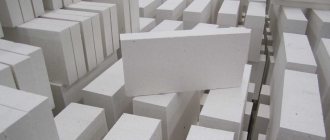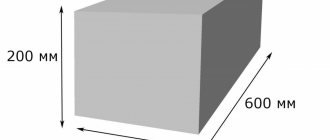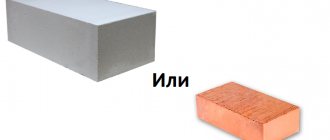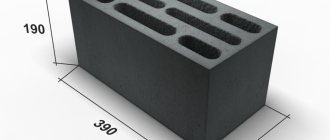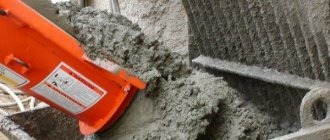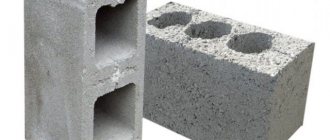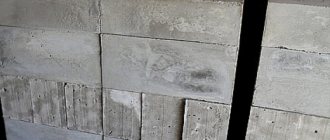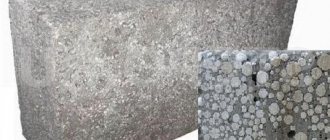Every customer counts on the rapid construction of a high-quality wall structure with minimized material costs. But due to ignorance of technology and installation nuances, it is difficult for the average person to determine which building material is more successful in his case. To carry out a thorough redevelopment today, the choice of tongue-and-groove or foam block is more often offered, which is better and when each of these products is more suitable, this article will help you figure it out.
Anatomy of partition building materials
Rectangular panels, with projections and recesses for joining, are usually made of gypsum, supplemented with hydrophobic and plasticizing components. The products have smooth surfaces. Regular ones are white, moisture resistant ones have a greenish tint. The most popular dimensions are 667x500x80 mm and 667x500x100 mm. Monolithic and hollow modifications are available. The characteristics are higher for hollow models. They are no less durable, but also 25% lighter. The panels are used in the construction of interior and apartment partitions - single 80 mm or double with an air gap of 40 mm.
Foam technology is based on the combination of concrete and foam filler. The output is gray bricks with air cells inside. Porosity determines key qualities. The running dimensions of the wall stone are 600x300x200 mm, the partition stone is 600x300x100 mm. The convenient format of the material allows you to build wall structures of any thickness, both in finished premises and in houses under construction.
An analysis of the advantages and disadvantages of building materials will help you figure out what is better suited for constructing internal walls - pgp or foam block.
What is a gypsum block
As you can guess from the name, it is made from gypsum. The element is produced in the form of a parallelepiped, it can either be solid, that is, solid, or have voids inside, this option is called hollow.
The solid one is denser and stronger, but the hollow one has a lighter weight, which is important from the point of view of both the load on the floors and the installation process itself. Also, this building material can be moisture resistant and ordinary
They can be distinguished by their appearance - the first option usually has a green tint.
The process of producing gypsum blocks involves mixing the main components (water, gypsum and additives) and then casting them into molds, where the mixture is fed under pressure. Then the whole thing hardens and dries. The attitude towards the quality of production is very attentive, usually all this happens under strict control.
One of the distinctive features of gypsum blocks is the tongue-and-groove connection system. On each parallelepiped there is a special protrusion on one end side, and a ridge on the opposite side.
These elements can be rectangular or trapezoidal. The tongue-and-groove system of gypsum blocks works on the same principle as that of laminate, which greatly facilitates the process of wall construction. In addition, the joining of elements is of very high quality. Partition blocks are available in two variations in size: the length is always 600 millimeters, the width can be 75 or 125 millimeters, and the height is 250 millimeters. Wall ones have a wider spread: the length and height are the same, but the width can be 200, 350 and 450 millimeters.
Evaluation of plaster characteristics
- Relatively light and bulky. The weight of the hollow structure is 20-22 kg. The 80 mm thick partition does not overload the load-bearing floor and saves usable space.
- Moderately durable. Various modifications tolerate loads in the range of 35 - 50 kg/cm?. During pilot testing, the plaster partition demonstrated the ability to withstand 200 kg per two fixation points. This means that it is quite suitable for installing attachments and plumbing fixtures.
- They have low thermal insulation, which is not so important when constructing light partitions in rooms. Thermal conductivity 0.43 W/m•C.
- They absorb noise well. Sound insulation meets regulatory requirements - 43 dB. According to SNiP, the indicator for interior walls in luxury dwellings is no less than 43 dB, and in standard and improved premises - no less than 41 dB.
- They repel moisture – 5%. This applies to moisture-resistant modifications that have acquired the property of resisting dampness due to hydrophobic additives. Water-repellent partitions are used to form bathrooms, showers, toilets and other rooms with a humidity level of up to 60%. To avoid direct contact with water, decorative tile cladding is used. The hygroscopicity of a standard gypsum product is quite high - about 25%. That is, it is afraid of dampness.
- Fire resistant. They can withstand 1000°C for 3 hours, which is extremely important for fire safety.
You cannot use gypsum panels for the construction of load-bearing structures. Due to overloads, such a wall will sag from below and eventually burst.
Main indicators characterizing GWP
Main technical characteristics of slabs with a tongue-and-groove connection system:
- heat permeability resistance is 0.025 (h×m×°C)/Kcal;
- noise insulation coefficient – ranging from 35 to 41 dB;
- density – 1350 kg/m³;
- water absorption: for moisture resistant ones - about 5%; for standard slabs - from 26 to 32%;
The standard size of a tongue-and-groove slab is 667×500 mm, and the width depends on the application and is 80, 100 or 120 mm.
The weight of the masonry as a whole depends on how much the individual product weighs: a standard size hollow gypsum tongue-and-groove block (667×500×80) weighs on average 23 kg, and a solid one – on average 31 kg; the weight of a silicate block measuring 500x250x70 mm is about 15.6 kg.
The GWP density of gypsum is 1350 kg/m³, and the GWP density of silicate is 1870 kg/m³: therefore, gypsum blocks have better heat and sound insulation than silicate ones.
Features of foam concrete
Foamed concrete blocks:
- Lightweight, but bulkier compared to its “competitor”. The weight of lightweight stone varies from 8.5 to 47 kg. A partition 100-200 mm thick steals more space. Therefore, when choosing which is better in terms of saving usable space, foam blocks or tongue-and-groove slabs, gypsum products have an advantage.
- Strong. Cement easily competes with binder gypsum in strength. And the product made from it is thicker and stronger. Such features allow concrete walls to withstand more loads, which significantly expands the scope of application of this building material.
- But at the same time they crumble upon impact. Fragility threatens combat during transportation and unloading.
- They are distinguished by high thermal insulation and soundproofing protection. Due to the uniformly porous composition (density from 400 to 1100 kg/m3), the thermal conductivity of lightweight concrete is insignificant 0.12–0.38 W/m·K, and the background sound index reaches 43 dB. These indicators are sufficient to insulate non-load-bearing walls, separate heated and cold rooms, as well as significantly reduce noise from the outside.
- They don't burn. Maintain 1200 °C for 4 hours. In terms of fire resistance they belong to class 1.
- Moderately moisture-resistant due to low density. Water absorption coefficient 14%.
It is quite possible to build load-bearing structures from lightweight concrete. And even build gazebos, garages, extensions, cottages and houses, depending on the brand of construction material.
“Competitors” are equal in environmental friendliness and resistance to aggressive biological processes. Both materials do not pollute the external environment with toxins, promote air exchange, and do not rot.
Comparative review of technical, physical and operational characteristics of materials
Let's look at the table.
Comparison of tongue-and-groove slabs and aerated concrete (and products made from it):
| Thermal conductivity | Due to its lower density, aerated concrete has a lower thermal conductivity coefficient. |
| Durability | Both materials are durable. |
| Ease of handling | Both materials are easy to saw and cut and there will be no difficulties. The installation of partitions in both cases is simple, but the slabs in the latter are still somewhat ahead, especially when compared with a gas block that does not have a groove and tongue. |
| Scope of application | Of course, we should pay tribute to aerated concrete. Its scope of application is wider. The tongue-and-groove slab is mainly used in the construction of partitions. This is its most common area of application. |
| Strength and Density | The strength and density of the slabs is higher. It can reach 1860 kg/m3, as mentioned earlier. Aerated concrete cannot boast of such value. |
| Additional costs for finishing | The slabs do not require subsequent plastering with cement-sand mortar. The wall turns out to be quite flat, the products are smooth. Finishing costs will be significantly lower. |
| Water absorption | Aerated concrete is more hygroscopic. Especially when you compare it with gypsum moisture-resistant boards, the water absorption of which is only 5%, as opposed to 25% for aerated concrete. |
If we talk specifically about partitions, then their construction is more practical using slabs. Moreover, this phenomenon is quite common, especially in multi-story construction.
On a note! It is now popular to build apartments without partitions. This allows the developer to place them at his own discretion. In this case, the use of tongue-and-groove slabs is especially important.
A brief overview of some modern alternative wall materials and how they compare with aerated concrete
As already mentioned, the building materials market is rich in a range of products. Let's compare the most popular and modern of them with aerated concrete and tongue-and-groove slabs.
On a note! Developers often ask themselves: sibit or aerated concrete - which is better? In this case, it is worth noting that sibit is autoclaved aerated concrete. This is not the name of a special material; moreover, sibit is a trademark that produces gas silicate.
Aerated concrete "Sibit"
At the moment, the construction of buildings using sip panels has become widespread. This is an American technology and it gained popularity in the domestic construction industry market not so long ago.
Let's find out which is better: aerated concrete or sip panels?
SIP panels
SIP panels are products consisting of two plates with insulation – expanded polystyrene – glued between them. They are actively used in construction using the so-called “Canadian technology” of construction.
It is associated with building a warm building in a short time, which, in turn, is due to the cold climatic conditions of the region. Let's look at the main differences between the materials in the table.
Comparison of aerated concrete and SIP panels:
| Strength | SIP panels are considered more durable and can withstand heavy loads. |
| Deformation, shrinkage | Shrinkage of SIP panels is about 1%. This is an insignificant indicator. They are practically not subject to deformation. |
| Temperature preservation | Aerated concrete releases heat faster. It is worth noting that the latter is only 2 times greater than the thermal insulation ability of brick. That is, SIP panels are ahead in this indicator. |
| Environmental friendliness | Both materials are environmentally friendly. |
| Variability and convenience of finishing | The variability of finishing is great in both cases. However, aerated concrete is a more capricious material; it requires especially careful finishing and increased adhesion. Moreover, the purchase of expensive specialized mixtures for plastering is required. |
| Durability | If the work is carried out technically correctly, both materials will last quite a long time. |
| Construction cost | This factor depends on many things. This is both the type of foundation and the type of cladding and interior decoration. In general, in most cases, a house made of SIP panels is cheaper, taking into account all factors and costs in general. |
As an alternative to gas block, there are Durisol wall products on the building materials market. This is also the name of the technology for producing blocks used to create permanent formwork for monolithic construction.
It has characteristics similar to aerated concrete, such as thermal conductivity, strength and durability. Finding out which is better: aerated concrete or durisol, for this reason, is quite difficult.
Durisol
It is worth mentioning the presence of such a competitive material as a heat block. It is a three-layer product consisting of a layer of expanded clay concrete, expanded polystyrene and artificial stone in the form of texture (facing side).
This is its main advantage. It does not require external finishing, and the thermal efficiency is increased. Also, the advantages include high strength and durability.
The disadvantage is the high price.
Which is better, aerated concrete or a heat block?
Often, doubts when choosing a material arise when searching for a leader in the “monolith-aerated concrete” competition. Again, much depends on the type of building, the desired result, requirements for quality indicators and planned construction costs.
Which is better: aerated concrete or monolith?
Monolithic walls will cost much more. But a structure can be durable and practical in both cases - subject to compliance with all construction norms and rules.
Comparing economic benefits
Taking into account the difference in the thickness of wall structures made of foam blocks (200 mm) or tongue-and-groove slabs (80 mm), one cannot fail to notice the advantages of a plaster partition:
- 2.5 times less volume of material required for installation;
- savings on adhesive mixture and cladding;
- reduction in delivery costs.
Due to the technological channels in hollow panels there is no need for gating. Electrical wires and small diameter pipelines can be laid in voids, which will also reduce construction costs. These facts compensate for the financial burden caused by the higher cost of the gypsum-polymer product.
What to install the internal partition from - tongue-and-groove or foam block
Every customer counts on the rapid construction of a high-quality wall structure with minimized material costs. But due to ignorance of technology and installation nuances, it is difficult for the average person to determine which building material is more successful in his case. To carry out a thorough redevelopment today, the choice of tongue-and-groove or foam block is more often offered, which is better and when each of these products is more suitable, this article will help you figure it out.
Comparison of the specifics of working with wall materials
The design of gypsum-polymer structures involves:
- Simplified installation using gypsum glue with economical mixture consumption. The maximum width of joints is 2 mm. Lightweight stone laying is also done on an adhesive basis. However, this creates connection seams up to 10 mm, which means more masonry mortar is required. The quality of masonry is significantly improved with the help of tongue-and-groove foam blocks. Products are also produced in this form.
- High productivity. The precise geometry allows the structure to be erected in an extremely short time. One worker can build up to 30 “squares” per shift, without special equipment. An imperfect shape can be attributed to the disadvantages of a lightweight stone. This fact certainly affects the installation speed. "Advice. Buy lightweight concrete only from reputable manufacturers. Large companies check the quality and dimensions of products in accordance with GOST standards. The smoothest building material is made by cutting.”
- Creation of a perfectly straight web thanks to the tongue-and-groove connection. Due to the joining of protrusions and depressions, the slabs are installed perfectly level. Thanks to the rigid connection, the partition acquires decent strength. The disadvantage of the material is that it is not suitable for the construction of curved structures.
- Gypsum panels can be sawed, planed, and nailed. As for foam concrete, it lends itself remarkably well to a carpenter’s saw and grinding tool. Various arch-type configurations are cut out in structures. They also make holes and cable channels.
- No wet painting processes. It is enough to rub the seams, carry out a light finishing treatment, and you can start covering the smooth slabs with wallpaper, and this is already a bonus to the budget. The same cannot be said about the “competitor”. Concrete walls require extensive finishing, including plastering and finishing.
A few secrets from experts
For installation with gypsum panels, it is extremely important to ensure the straightness of the base. Ideally, this is a concrete screed. As well as additional rigid fixation of the structure using metal corners. They are attached to the walls, especially in the locations of the hinge parts of the door, and to the floor. Fixation is required if the floor and wall surfaces are made of plasterboard or wood. If the above requirements are met, the installation will take place as quickly as possible, and the quality of the partitions will be ideal.
The first row of the block structure is laid out on a flat base, previously cleared of dust and primed at the same time as the wall. All further work and its results depend on the quality of the initial masonry. No auxiliary fasteners are required. It is best to insulate the upper border of the junction with polyurethane foam. This will provide additional sound insulation of the room and protect against shrinkage processes.
When installing cabinets and plumbing to partitions, it is necessary to select the correct fasteners. This is a spacer dowel that folds into a knot when it enters the voids of the structure body.
Conclusion
In a test drive called “Which is better - tongue-and-groove slabs or foam blocks”, gypsum plaster wins in terms of efficiency and speed of redevelopment. Builders will construct and clad the lightweight structure quickly and at reasonable cost. Installing a concrete partition will be more expensive, but it will be stronger and more reliable.
External walls and partitions can be built from foam blocks
Looking for an answer to the question: “Tab-and-groove blocks or foam blocks – which is better?”, it makes sense only after explaining what kind of material is meant by the common term “tongue-and-groove”. And this is nothing more than gypsum blocks and slabs, which, although they are a structural material, cannot be used for the construction of load-bearing walls.
The reason for this is the presence of gypsum in the blocks - a binder that cannot compete with cement in terms of the strength of the stone formed. Therefore, their advantages can only be compared exclusively as a material for the construction of internal non-load-bearing fences.
Partition materials of domestic production
The level of confidence in the domestic range of similar products is growing.
The list of popular partition materials includes Volma gypsum tongue-and-groove slabs. Reviews on construction sites are mostly positive. A small volume of manufactured products satisfies the demand of the local construction market, so high-quality and durable materials are exported outside the region in small quantities.
Characteristics of tongue-and-groove slabs
We think everyone understands that “plaster” means products cast from gypsum. Of course, they also contain other mineral components that give the blocks certain properties, but gypsum is the binder. They are manufactured according to GOST 6428, which has been in force since 1983.
Types of plaster
In it, the products used for the construction of partitions are presented as slabs of two design options:
- With grooves and tongues (PLG) . The ridge can be rectangular or trapezoidal, but this does not affect the quality of the structures being built.
The photo shows a slab with grooves and ridges - a variant with voids
- Only with grooves (PlP) . In this case, the cavities formed when two blocks are joined are filled with solution.
Connection of groove blocks
However, only tongue-and-groove options are positioned as products of the highest quality. That is, the maximum permissible deviations in their length are no more than 2 mm, width 1 mm, and thickness 0.5 mm.
In products of the first category, which are groove slabs, these figures increase by two or even three times. Naturally, their price will be lower.
The current standard provides for only 4 standard sizes of slabs:
This is the length and height of the slabs. In terms of thickness, there are only 2 options: 80 or 100 mm.
Considering that this standard is already more than 30 years old, and time does not stand still, other options have appeared, including hollow ones. Yes, and there are different sizes. In this case, the products are manufactured not according to GOST, but according to specifications that are developed by the manufacturers themselves.
Features for comparison
To understand which is better: tongue-and-groove or foam block, you need to know everything about the advantages and disadvantages of both materials.
The undoubted advantages of gypsum slabs include:
- Light weight;
- High level of thermal insulation;
- Excellent sound absorption;
Slabs with voids have an even higher level of these characteristics. Also, gypsum blocks may contain hydrophobic additives, which allow them to be used to build partitions in wet rooms. In this case, they are called moisture resistant, and have slightly different indicators.
Tongue-and-groove or aerated concrete - which is better: a comparative analysis of materials and their basic properties
During construction work, most likely, more than one developer has faced the problem of choosing the optimal material. The relevance of this issue is only growing every year.
This is due to the emergence of an increasing number of new materials produced using modern technologies and endowed with competitive qualities. The right decision will help you save money and, at the same time, not lose quality.
In this article we will try to make the right choice and answer the question: tongue-and-groove or aerated concrete - which is better? Tongue and groove have a large number of different products, so we will consider and compare the most popular of them, which are: tongue-and-groove slabs and some types of building blocks.
Types and properties of foam concrete wall products
Foamed concrete blocks are today one of the most popular structural materials in private construction. The reason for this is the low cost, a convenient format that can be selected for a wall of any thickness, and effective characteristics, which consist mainly of a low level of thermal conductivity.
If the use of gypsum blocks is limited to the construction of partitions and internal walls, then foam blocks can be used to build a cottage, a garage, a gazebo, and a house.
Comparative characteristics of foam blocks
There are 10 types of wall products, which determine their dimensions. The installation option may also be different, of which there are only two: mortar-based and glue-based. All standard sizes are presented in the table below.
As you can see, not every type of block can be mounted with glue. There are much more dimensional options here than with gypsum slabs. In shape, they can also be a smooth stone, have grooves and ridges, or just grooves.
- Foam blocks have the lowest thermal conductivity coefficient of all construction materials - 0.18 (W*m*0C), which is the most significant advantage when it comes to the construction of external walls.
- And in general, all cellular concretes are not only structural, but also heat-insulating materials.
- The difference between one and the other lies in their density, and, accordingly, strength. Structural blocks acquire higher strength by adding a reinforcing component – fiber fiber – to the concrete mass.
The purpose of the block is indicated by its brand:
- Products from D150 to D400 are purely thermal insulating, so their strength and frost resistance are not standardized at all.
- Blocks of grades from D500 to D900 are thermal insulating and structural. They have higher strength while maintaining good insulating properties. They are used mainly for laying internal walls, partitions, and parapets on loggias.
- Purely structural grades are from D1000 to D1200. These are very durable blocks that are used to build load-bearing walls. However, the higher the density of the stone, the fewer pores it has - which means the higher the thermal conductivity.
Product varieties
The entire range of products is classified according to several criteria:
- the raw materials used;
- production method;
- filling;
- moisture resistance;
- sizes.
When choosing a building material, be sure to take into account all the features of the blocks.
Gypsum GGP blocks
Gypsum boards are produced using casting technology from gypsum grades G-4 and G-5. By adding plasticizers, they achieve increased strength and improved appearance - the walls are even and smooth.
Thanks to natural raw materials, the walls are safe, and the structure of the gypsum makes them breathable.
Additions of granulated blast furnace slag and Portland cement reduce water absorption. To identify moisture-resistant products, they are painted in shades of green.
Comparative characteristics of the varieties are collected in the table.
| Characteristic | Regular | Moisture resistant |
| Density, t/m3 | 1350 | 1100 |
| Water absorption,% | up to 32 | 5 |
| Strength grade | M35 | M50 |
| Sound absorption, dB | 34–41 | |
| Thermal conductivity, W/m*S | 0,19 |
In addition to instability to moisture, gypsum is subject to accelerated destruction under the influence of climatic conditions - direct sunlight and aggressive chemical elements in the air.
Gypsum blocks can withstand open fire with a flame temperature of up to 1100°C for 3 hours without loss of quality.
Silicate blocks
The production technology provides:
- Preparation of a mixture consisting of water, quicklime and quartz sand.
- Pressing raw blocks.
- Drying in an autoclave chamber under pressure and at high temperature.
The finished products are a durable sand-lime conglomerate.
The density is about 1850 kg/m³, therefore, for ease of work, tongue-and-groove silicate blocks are made smaller in size than gypsum blocks.
The water absorption level is about 13%, so silicate slabs have no restrictions on use in wet areas.
Strength grade M150 allows the use of silicate GGP in the construction of load-bearing walls. For external structures, you will need to create a waterproofing layer. For example, houses made of silicate blocks can be plastered, a wet thermal insulation method can be used, or a ventilated façade can be installed.
Which blocks do you prefer?
Plaster 0%
Silicate 100%
I will choose another material 0%
Voted: 1
Filling
Blocks are produced in the form of hollow or solid slabs.
Elements with voids retain heat better and are lighter in weight. The total weight of each block is reduced by 25%
The wall puts less load on the floor, which is especially important in apartment buildings when carrying out redevelopment. At the same time, voids sharply reduce the strength of blocks
Standard sizes
The manufacturer has the right to determine the dimensions of his products, however, in order to maintain uniformity and interchangeability of products from different factories, GOST 379-2015 recommends adherence to the following sizes of silicate partition slabs marked SP:
- products with a thickness of 65 mm can have dimensions in length and height - 248x248 or 248x240;
- products with a thickness of 70 mm and a height of 248 mm are produced in standard lengths from 248 to 998 mm;
- for products with a thickness of 80, 85 and 90 mm, the length can be from 248 to 998 mm, with a height from 198 to 248.
Enlarged silicate partition slabs are produced with a length of 998 mm, a width of up to 130 mm and a height of up to 248 mm.
Gypsum slabs for partitions are manufactured in accordance with GOST 6428-83. There are much fewer standard sizes available for them compared to silicate ones.
The standard provides for only two thicknesses - 80 or 100 mm, and the length and width dimensions require only 4 GGP sizes:
- 667x500 mm;
- 900x300 mm;
- 800x400 mm;
- 600x300 mm.
Pros and cons of GPP
Quick construction of partitions and easy adjustment of blocks Low glue consumption, since the seams have a minimum thickness With careful laying, the surface can do without leveling plaster Environmental safety under any operating conditions Fire resistance Low thermal conductivity coefficient High sound insulation properties Saving usable space due to the small thickness of the slabs
Low strength of gypsum products High rate of water absorption, protected slabs are much more expensive It is difficult to attach heavy objects to hollow blocks Minor movements of the ceiling lead to cracks in the walls
Tongue-and-groove slab
Construction structural material based on gypsum. Designed for the construction of internal partitions in apartments and private houses. With its help, you can build both a partition in a dry and wet room.
A distinctive feature of the PGP (this is how a tongue-and-groove slab is shortened) is its visible ridge, or more simply a tongue-and-groove for fastening the slabs together. Two adjacent ends of the slab have a tenon, and the ends opposite them have a groove.
This design of the slab makes it possible to increase the strength of the partition even at the stage of its installation and reduce deviations from its verticality.
However, this does not mean that the PGP slabs do not need to be glued together. For their monolithic coupling, special gypsum adhesives are used, sold both in dry and ready-made form. The thickness of the resulting single-layer partition is 10 cm. The weight of one solid slab is 22 kg.
Sound insulation of tongue-and-groove gypsum partition
When a major renovation is planned in an apartment with the installation of an interior partition, most people give preference to inexpensive building materials, such as tongue-and-groove slabs. These products are easy to install, light in weight, and their cost is quite reasonable. The only drawback is poor sound insulation. In order for the partition to retain extraneous sounds as effectively as possible, it must initially be correctly erected taking into account sound insulation.
@PGP
As you know, sound insulation can provide coziness and comfort in an apartment, not just one surface, but the entire walls, ceiling and floors. It is worth noting that the construction of a partition from PGP should be done only after the work on the floors and ceiling has been completed. The thing is that the partition, even if it is not load-bearing, can transmit vibrations and structural noise from rigid fastening. To eliminate this possibility, the ceiling and floors are initially completely soundproofed.
For the floor, the optimal solution would be a floating floor, thanks to which it will be possible to protect the floor covering from excess vibration. The installation of PGP slabs is carried out in such a way that the blocks at the top do not fit tightly to the ceiling. If you make a rigid screed, you can forget about soundproofing the partition. Some people use mounting foam to blow in the upper space, but in reality this is not correct.
When construction foam dries, it becomes hard, so all vibrations will be transferred to the partition; if you use special soundproofing materials. As an alternative, you can lay mineral wool in the opening and seal it with a sealant that will prevent vibration.
Soundproofing properties of GGP
Today, two types of GGP boards are used in construction: gypsum and silicate. As for the former, they are made by casting from gypsum and special additives. Thanks to the production technology, the products receive the correct shape with grooves. Slabs are also made from quicklime, sand and other additives using pressing technology. It is worth noting that gypsum structures have slightly higher heat and sound insulation values than silicate blocks.
@PGP
Both materials are produced on the basis of environmentally friendly materials, due to which they are widely used in frequent construction, and in particular for the construction of interior partitions. Also, the features of the building material include the non-flammability of products and hypoallergenic characteristics. If you install a partition made of tongue-and-groove slabs, then it is necessary to do additional sound insulation, since the degree of retention of sound waves is only 41 decibels.
Partition foam block
When talking about foam blocks in comparison with PGP, we mean partition foam blocks with dimensions starting from 625x100x250 mm. Otherwise they are called gas silicate blocks or autoclaved gas concrete blocks.
They are made not from gypsum, but from cellular concrete (foam concrete). The presence of pores in the material makes it much lighter than concrete and brick. The weight of a solid gas silicate block 600x100x300 mm is about 15 kg. This is the main advantage of such material.
Not only partitions are built from foam blocks, but houses are built from larger blocks, using them as the main material for the external walls of the house.
Strength
It is difficult to compare the strength of walls made of these materials.
If we talk about compressive strength, then gypsum in terms of “pure” indicator is much higher than cellular concrete. But gypsum board with a thickness of 12.5 mm cannot be called durable in comparison with a building block. A wall of such thickness is not able to withstand any serious load from hanging furniture or household appliances. The best thing in this regard is walls made of aerated concrete blocks (foam block partitions are looser). Although their wall thickness must be at least 100 mm in order to hold the fasteners well under high loads.
But the good thing about the multilayer construction of a plasterboard partition is that it can always be adapted to perform any functions. To increase local strength, you can use embedded wooden elements (timber, board or OSB sheet). The overall strength can be improved by using additional vertical and horizontal frame members and sheathing with two sheets of gypsum board on each side.
And if we talk about the strength of the connection with the enclosing surfaces (load-bearing walls, floor and ceiling), then attaching metal profiles to them using dowels and anchors is much more reliable than an adhesive solution of building blocks.
Differences between PGP and foam blocks
Visually, the foam block does not have any grooves or protrusions. Its ends are smooth. This is the second difference, after weight, between foam block and PGP.
The third difference between these materials is their attitude to moisture. All foam blocks tolerate humidity above 60%. To install a partition in a wet room, you need to buy only special PGP for wet rooms.
In terms of price, GPPs cost from 550-650 rubles per sq. m. meter, depending on the type and manufacturer of the slabs. The cost of foam blocks 100 mm thick is about 300-350 rubles per meter of partition.
- Here we could say that gas silicate blogs are more profitable to buy than GGP. However, the surface of a high-quality PGP does not require additional preparation such as plaster . With high-quality installation and grouting of the joints, the partition made of PGP is ready for painting or wallpapering.
- The partition made of foam blocks must be plastered and go through the standard stages of preparing the walls for finishing.
General description of building material
Tongue-and-groove slabs are gypsum or silicate panels used for the manufacture of building structures in enclosed spaces.
The grooves and ridges available simplify the construction of walls, as they allow the individual elements to be accurately oriented to each other.
Installation is carried out using a special glue , due to which there are practically no gaps and seams, which facilitates finishing.

